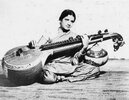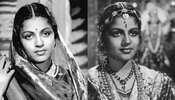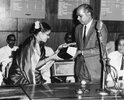
Madurai Shanmukhavadivu Subbulakshmi, popularly known as M.S Subbulakshmi, was a renowned Carnatic vocalist. The serenity on her face also reflected through her singing. The first musician ever to be awarded the Bharat Ratna, India’s highest civilian honor, Subbulakshmi was also the first Indian musician to receive the Ramon Magsaysay award.
She made her way to people’s hearts through her classical and semi-classical songs in the Carnatic tradition. She took every listener on a pilgrimage to their higher goals and sentiments with just her singing. On her birth anniversary, PBNS pays tribute to the maestro who continues to inspire generations of singers.
Early steps
On September 16, 1916, India was honored with a musical gem with the birth of M.S. Subbulakshmi in Tamil Nadu’s Madurai.
It is said that one’s names have an impact on one’s character. In the case of Subbulakshmi, her place of birth, Madhurapuri influenced the life she was going to make for her. Madhurapuri, meaning the city of sweet nectar resonates with the singer’s sweet nectar-like voice that continued to mesmerize the world for ages.
She diligently devoted hours to music practices. It is said she practiced her ragas even between household chores. Subbulakshmi was five when she began her formal training in music, and at age eight, she delivered her first stage performed.
Affectionately called MS Amma, she mostly sang in Tamil, Telugu, Kannada, and Meera Bhajans in Hindi. She was not just the face of Carnatic music, but also a great actor donning the roles of Meera and Sakunthala on the silver screen.
To her, music meant connecting to God
Amma connected with God through music. In turn, she let several thousand connect to Govindam through her music. Vice President M Venkaiah Naidu had once said, a ‘Bhajagovindam’ or a ‘Bhavayami’ elevated the listener to a higher plane of emotion or bhakti. Her ‘Suprabhatam’ woke us up to a deeply spiritual reality. The bhava and rasa which her music inspired, overwhelmed the Rasikas and often left them in tears.
In the words of VP M. Venkaiah Naidu, Dr. M.S. Subbulakshi with her divine and enchanting voice brought a huge transformation on the cultural canvas of this country. She traveled all over the world enthralling audiences with her music. The UN General Assembly invited her (the first Indian musician) to perform where she left the audience spellbound. Amma opened a vibrant dialogue between the north and the south and the west and the east. She was humble, graceful, simple, and spiritual grandeur.
Subbulakshmi’s heart and soul entwined when she sang. Her rendition captivated all with enduring charm that is sweet, memorable, absorbing, and magical. Be it the pronunciations, or alapana, kriti or swara, or the bhajans or patriotic ones, or songs of the eminent composers or of the lighter variety, the maestro gave it her all.
The veteran was acknowledged for the clarity of her pronunciation, precision in the placement of her sruthi, her ability to sustain notes. She could easily control her breath. Balance and proportion was the mantra behind her singing.
Amma also made a huge contribution to popularizing Annanmacharya Kritis. She undertook more than 200 charity concerts and donated the royalties she had earned on devotional albums to the Tirumala temple.
Honors & Recognition
“Her music is a gift of the Gods which she plays at the service of the nation” – Dr. Sarvepalli Radhakrishnan
M.S. Subbulakshmi’s music was an instrument of motivation for people, especially during the freedom movement. The great Sarojini Naidu surrendered her title ‘Nightingale of India’ after listening to M. S Subbulakshmi sing. She even left Gandhiji surprised with her rendition of ‘Vaishnava Janatho’. She also recorded Gandhiji’s favorite Meera bhajan ‘Hari Tum Haro’ overnight and sent it to him on his birthday in 1947.
She has been called “Tapaswini” by Lata Mangeshkar, “Suswaralakshmi Subbulakshmi” by Ustad Bade Ghulam Ali Khan.
She performed at the Edinburg International festival and for Queen Elizabeth-II at the Royal Albert Hall, London. She received all possible honors of the nation, from SangitaKalanidhi to Bharat Ratna. Sri Shanmukhananda Bharat Ratna Dr. M.S. Subbulakshmi Fellowship is awarded to music students in her honor.
Prasar Bharati Archives
Amma left the world on 11 December 2004, but she continues to be one of the brightest stars of Carnatic music. Tune in to these Prasar Bharati archives to experience the magic of the phenomenal M. S. Subbulakshmi.




